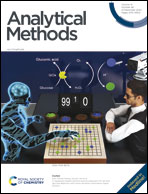A regression-based machine learning approach for pH and glucose detection with redox-sensitive colorimetric paper sensors†
Abstract
Colorimetric paper sensors are used in various fields due to their convenience and intuitive manner. However, these sensors present low accuracy in practical use because it is difficult to distinguish color changes for a minute amount of analyte with the naked eye. Herein, we demonstrate that a machine learning (ML)-based paper sensor platform accurately determines the color changes. We fabricated a colorimetric paper sensor by adsorbing polyaniline nanoparticles (PAni-NPs), whose color changes from blue to green when the ambient pH decreases. Adding glucose oxidase (GOx) to the paper sensor enables colorimetric glucose detection. Target analytes (10 μL) were aliquoted onto the paper sensors, and their images were taken with a smartphone under the same conditions in a darkroom. The red-green-blue (RGB) data from the images were extracted and used to train and test three regression models: support vector regression (SVR), decision tree regression (DTR), and random forest regression (RFR). Of the three regression models, RFR performed the best at estimating pH levels (R2 = 0.957) ranging from pH 2 to 10 and glucose concentrations (R2 = 0.922) ranging from 0 to 10 mg mL−1.



 Please wait while we load your content...
Please wait while we load your content...